

Arctic Information for Kids. The USAP Portal: Science and Support in Antarctica - South Pole Station Webcams. Status: Waiting for Satellite Visibility Refreshing in 30 seconds...
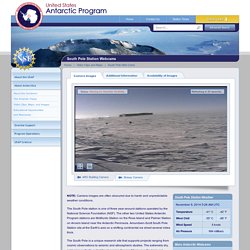
ARO Building Camera Skiway Camera A Black and White Photo of the Atmospheric Research Observatory (ARO) National Geographic Kids. Emperor Penguins, Emperor Penguin Pictures, Emperor Penguin Facts - National Geographic. Emperors are the largest of all penguins—an average bird stands some 45 inches (115 centimeters) tall.

These flightless animals live on the Antarctic ice and in the frigid surrounding waters. Penguins employ physiological adaptations and cooperative behaviors in order to deal with an incredibly harsh environment, where wind chills can reach -76°F (-60°C). They huddle together to escape wind and conserve warmth. Individuals take turns moving to the group's protected and relatively toasty interior. Snowy Owl Facts and Pictures. When you see a snowy owl, it's clear how the bird probably got its name: they're snow-white.

Males are generally whiter than females. As males grow older, they get whiter. The females never become completely white—remaining brownish with darker markings. These large owls mainly live in the Arctic in open, treeless areas called tundra. Snowy owls perch on the ground or on short posts. Snowy owls have excellent eyesight, but they obviously can't see their prey when it's underneath snow or a thick layer of plants. In flight, snowy owls generally cruise low to the ground. Most owls sleep during the day and hunt at night, but the snowy owl is active during the day, especially in the summertime.
Snowy owl pairs usually mate for life. Owl Babies - YouTube. Animal Facts: The Polar Bear. [en español] Approximate worldwide winter distribution of polar bears (light gray).
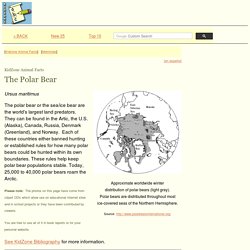
Polar Bears, Polar Bear Pictures, Polar Bear Facts - National Geographic. Polar bears roam the Arctic ice sheets and swim in that region's coastal waters.
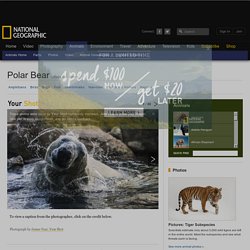
They are very strong swimmers, and their large front paws, which they use to paddle, are slightly webbed. Some polar bears have been seen swimming hundreds of miles from land—though they probably cover most of that distance by floating on sheets of ice. Polar bears live in one of the planet's coldest environments and depend on a thick coat of insulated fur, which covers a warming layer of fat. Fur even grows on the bottom of their paws, which protects against cold surfaces and provides a good grip on ice. The bear's stark white coat provides camouflage in surrounding snow and ice. These powerful predators typically prey on seals. Females den by digging into deep snow drifts, which provide protection and insulation from the Arctic elements. Polar bears are attractive and appealing, but they are powerful predators that do not typically fear humans, which can make them dangerous. Igloo - Wikipedia, the free encyclopedia. Community of igloos (Illustration from Charles Francis Hall's Arctic Researches and Life Among the Esquimaux, 1865) An igloo (Inuit language: iglu,[1] Inuktitut syllabics ᐃᒡᓗ [iɣˈlu] (plural: igluit ᐃᒡᓗᐃᑦ [iɣluˈit]) or snow house is a type of shelter built of snow, originally built by the Inuit.
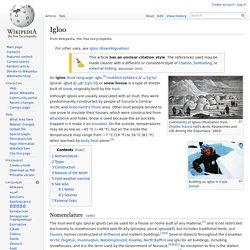
Although igloos are usually associated with all Inuit, they were predominantly constructed by people of Canada's Central Arctic and Greenland's Thule area. Other Inuit people tended to use snow to insulate their houses, which were constructed from whalebone and hides. Snow is used because the air pockets trapped in it make it an insulator. On the outside, temperatures may be as low as −45 °C (−49 °F), but on the inside the temperature may range from −7 °C (19 °F) to 16 °C (61 °F) when warmed by body heat alone.[2] Nomenclature[edit] Types[edit] How to Make a Perfect Igloo - Ray Mears World of Survival - BBC - YouTube. Arctic-Images. Arctic - Wikipedia, the free encyclopedia. Antarctica - Wikipedia, the free encyclopedia. Continent Antarctica, on average, is the coldest, driest, and windiest continent, and has the highest average elevation of all the continents.[6] Most of Antarctica is a polar desert, with annual precipitation of 200 mm (7.9 in) along the coast and far less inland; there has been no rain there for almost 2 million years, yet 80% of the world freshwater reserves are stored there, enough to raise global sea levels by about 60 metres (200 ft) if all of it were to melt.[7] The temperature in Antarctica has reached −89.2 °C (−128.6 °F) (or even −94.7 °C (−135.8 °F) as measured from space[8]), though the average for the third quarter (the coldest part of the year) is −63 °C (−81 °F).
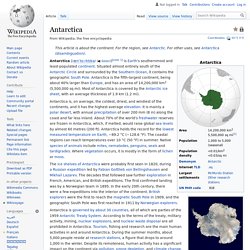
Anywhere from 1,000 to 5,000 people reside throughout the year at research stations scattered across the continent. Discovering Antarctica - teaching and learning resources on Antarctica. The Antarctic - Travel Guide, Info & Bookings – Lonely Planet. No place on earth compares to this vast white wilderness distilled to an elemental haiku: snow, ice, water, rock.
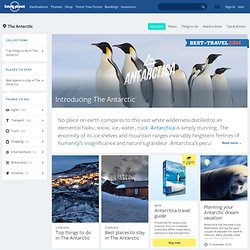
Antarctica is simply stunning. The enormity of its ice shelves and mountain ranges invariably heightens feelings of humanity’s insignificance and nature’s grandeur. Antarctica’s peculiar beauty may haunt you for the rest of your days. Even the trip over, crossing the Southern Ocean is an experience – with no landmass, low-pressure systems circle clockwise unimpeded, eventually reaching incredible speeds. The Falkland Islands in the South Atlantic are often included in a trip to Antarctica Because the continent has never had a native population – even today, scientists and other staff members at research stations are only temporary residents – Antarctic wildlife is still unafraid of people.